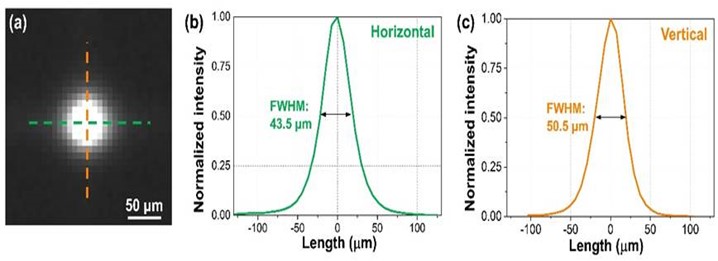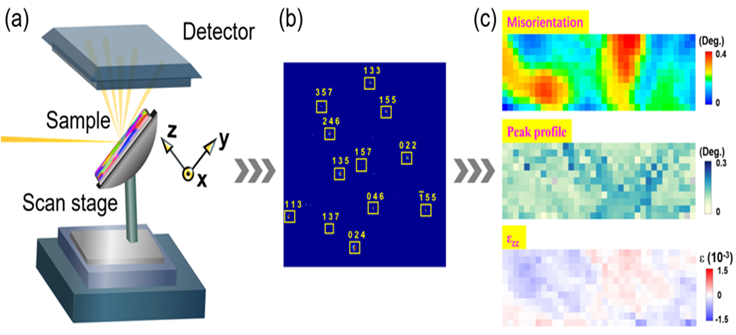Great Progress of Micro-Laue Diffraction at Shanghai Synchrotron Radiation Facility
As an advanced material characterization technology, Synchrotron radiation-based micro-Lauetechnique has both micron/submicron spatial resolution and centimeter sample characterization ability, especially its excellent ability to quickly detect crystal orientation and lattice stress/strain, showing unique and important application potential in materials, physics, chemistry and other disciplines. Recently, Shanghai Institute of Applied Physics, Chinese Academy of Sciences, Shanghai Synchrotron Radiation Facilityand Xi’an Jiaotong University have made important progress in the field of synchrotron radiation-based micro-Laue diffraction. The research team realized the micron-sized focusing of X-ray white beam (energy range 4~30 keV) by using the self-developed white beam KB focusing mirror system at Shanghai Synchrotron Radiation Facility X-ray test beamline (BL09B), and established the experimental method of white beam micro-Laue diffraction through the coordinated control of the surface detector and the scanning sample stage. Through the white beam micro-focusing work in BL09B, accumulated white beam debugging and using experience, which is conducive to speeding up the construction of micro-Laue diffraction line station and opening it to users.

Size of the focal spots of KB mirror
The Laue diffraction data analysis system was independently developed. Through the innovation of data analysis strategy and algorithm, the automatic and rapid quantitative analysis of massive Laue diffraction spectrum was successfully realized, and the analysis efficiency was nearly two orders of magnitude higher than that of the most advanced similar software in the world at present, and the microscopic defect characterization based on Laue diffraction linear analysis was realized. This is the first synchrotron radiation micro-Laue diffraction data mining software with independent intellectual property rights in mainland China.
In China (excluding Taiwan Province), the scanning synchrotron radiation-based micro-Laue diffraction technology was used for the first time to conduct a cross-scale and high-throughput quantitative study on the microstructure characteristics of the self-developed molten salt reactor nickel-base superalloy GH3535 base metal and welding samples. The spatial distribution of important microstructure features such as crystal orientation, lattice strain and micro-defects in the sample can be obtained by one experiment, which provides an experimental basis for understanding the welding properties of the alloy.

The research titled "Development of Micro-Laue Technique at Shanghai Synchrotron Radiation Facility for Materials Sciences" was published online in SCIENCE CHINA Materials magazine jointly sponsored by Chinese Academy of Sciences and National Natural Science Foundation of China (DOI: 10.1007/s40843-021-1648-3) as the cover article.
The research was supported by the national key research and development program (2016YFB0700404) and the national natural science foundation (91860109, u2032205, 51671154, 51927801).
Article connection: http://engine.scichina.com/doi/10.1007/s40843-021-1648-3
(Contributed by Shanghai Synchrotron Radiation Facility & Department of Molten Salt Machinery Engineering, SINAP).








